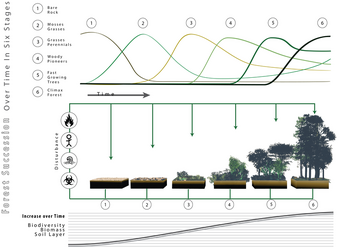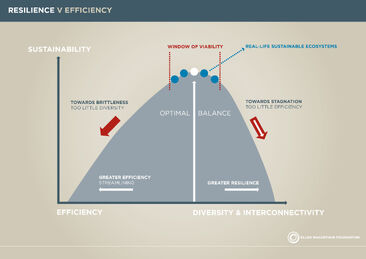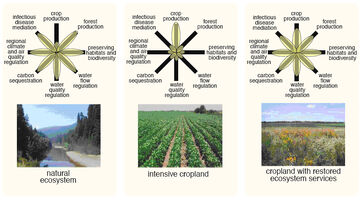The circular economy, like all economies, is about flow. The flow of energy and materials which produce what we use or consume and the flows of money which enable exchange. What is different about the flows in a circular economy is that unlike the linear economy all of these flows matter. To see why this is important it is easiest to look at an example from living systems. Take an example of a piece of land which has a forest on it. Over time the forest will have evolved through several stages in an adaptive way to be the fine mature forest we are assuming exists now.

In the forest stage to the right of the diagram, soils have built up, there is a lot of diversity and energy and material flows are tapped by plants and animals with the result that energy flows effectively, waste is food and the forest is resilient. This means that if a part of it is destroyed, say by an avalanche or a forest fire it will usually repair itself.
“Resilience is the capacity of a system to absorb disturbance and reorganise while undergoing change so as to still retain essentially the same function, structure, identity, and feedbacks.”
To do this there has to be a number of features. There has to be redundancy, meaning that there are many ways that the damage can be repaired. For example repair can come from combinations of plants and animals or from bacteri, fungi, etc, and within each category there are many different sub-species which can do the job (diversity) and that these are spread out so that it is unlikely that damage in one area eliminates all of a particular population.
A comparison in engineering is the resilience around the ability to lower the wheels on some commercial airplanes.
They can be lowered electronically, hydraulically, or manually (redundancy and diversity), and the control systems for each one are all located in different parts of the plane (distributed). The expense of the resilient systems seems ‘worth it’.
In a system designed for efficiency the expense of having a resilient system is seen as wasting resources. In the forest example, the land might be cleared to grow just a single crop, since every other plant and animal competes for the available energy and material flows. The system is simplified. Perhaps artificial fertilisers keep up the nutrients lost from harvesting, perhaps machines are used to cut down the need for human labour or pesticides to guard against pests. The capital which was built up in the soil, for example the carbon or the mycelial structure of the soil is degraded in search of more throughput. Wastes are not always captured as food and run off from
pesticides and fertilisers are externalised (sent elsewhere where they may cause damage). Most significantly, the more efficient the system the more brittle it is. This means it is like glass or a person who is under stress: a shock or disturbance causes a shattering or a major breakdown.
Apparently all systems with flow, whether energy, materials or digits in the banking system, experience a similar
trade off between efficiency (and brittleness) and resilience (adaptive to shock but slow to change more fundamentally). Here is a graphic that shows this relationship.

To optimise the system means finding that place between too much efficiency, risking large scale breakdown from time to time, and too much resilience, which risks stagnation and struggles to accept change. Imagine a traditional village in a remote location which is well adapted to its circumstances. It may be an enduring village, but it may resist change. Its young people will then, in turn, find the community’s inability to change offers them little motivation, and so lacking efficiency, life for the villagers is very hard.
In a circular economy, all the flows matter because it is whole systems approach and what is sought is a healthy system in a positive relationship to the part which we are especially interested in. Lets take food as a final example.

The US Department of Agriculture diagram illustrates the systems of natural ecosystems, intensive cropland and cropland with restored ecosystem services, an optimised system providing multiple benefits. The sum of these multiple benefits is greater than the value of the food alone even if the food production in the short term would be greater in intensive cropland than in the optimised system. The hidden costs of the externalities would have to be factored in, especially the risk of brittleness and collapse. Therefore, it makes sense to look at the system as a whole and identify and account for, and use the other benefits, including reduced risk. The final star diagram is what we are looking for in optimised systems. It is found near the top of the efficiency versus resilience curve.